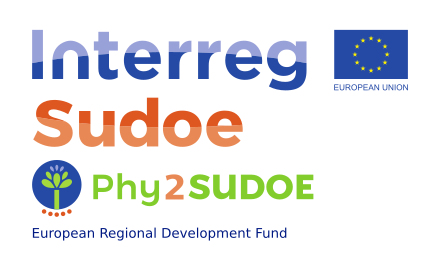09 Jun Progress of GT2
GT2 is the work package focused on expanding the PhytoSUDOE network, with the addition of new sites and phytomanagement options under a variety of soil and climatic conditions.
The PhytoSUDOE network (8 sites) was joined by 7 new sites (and 1 associated site) with new casuistry (other land uses, organic pollutants, and mixed contamination) in different soil and climatic conditions. Those sites include new mining areas and urban and industrial areas in order to widen the range of future uses (i.e. peri-urban green belts, parks, industrial crops, etc.).
NS1: DURANDEAU (Charente, FR)
Since 2004, the Charente County is owning a former industrial wasteland with an area of 1.08 hectares, located in a residential area of the city of Angoulême. This site was operated from 1936 to 1984 by the LECLANCHÉ then the SAFT companies for the manufacture, repair and recharging of batteries and accumulators.
The various investigations carried out since 2018 as part of the interpretation of the state of the environment and the management plan have confirmed the presence of numerous impacts on the site.
In March 2021, soil was sampled in the 0.05 – 0.90 m soil layer under the supervision of the Charente County. This corresponded to the North-East angle of the site, which displayed high metal(loid) and TCE concentrations in the soil.
Poplar cuttings (Populus nigra L.) were sampled at the St Médard d’Eyrans by INRAE to prepare rooted poplar plants and to cultivate them thereafter in this Durandeau soil. Potted soils will be placed in the INRAE greenhouse to assess the rhizodegradation / bioremediation of organic contaminants and the phytovolatilization of metal(loid)s.
In April 2021, a phytotoxicity test was carried out by INRAE with potted soils, radish and dwarf beans. Despite the soil contamination by metal(loid)s and TCE, the preliminary results displayed a low phytotoxicity on radish plants. Visible symptoms were a slight bronzing of the cotyledon leaves, a slight purple coloration of the hypocotyl, and a reduced surface area of the cotyledon leaves. With elapsed time, only the slight reduction of the surface area of cotyledon leaves remained visible. Phytotoxicity tests are ongoing.
The concrete slab was removed in March 2022 on roughly 200 m² under the supervis ion of La Charente County partner and HPC-Envirotec. Then the 0 – 0.50 m soil layer was loosened. This area displayed high metal(loid), PAH, PCB, and trichloroethylene concentrations in the topsoil. Based on previous pot experiments carried out by INRAE, compost (5% w/w) was incorporated into the topsoil. Thereafter an initial plant community (i.e. mycorrhized black poplars, goat willows, vetiver, Miscanthus x giganteus, Amorpha fruticosa, Agrostis capillaris, Festuca pratensis, Medicago sativa, and Lolium perenne, all plants prepared by INRAE) was implemented to promote the phytostabilization of metal(loid)s, the Cd/Zn phytoextraction (by collecting poplar and willow leaves in autumn), rhizo/biodegradation of organic xenobiotics, and soil cover to prevent wind erosion and water runoff. Besides, six large lysimeters were loaned to La Charente County and implemented at this site. Three lysimeters were filled with compost-amended soil and three others with unamended soil (from the field trial) to monitor changes in the drainage water. One mycorrhized poplar and A. capillaris were transplanted into each lysimeter. The monitoring of this field trial is supervised by La Charente County, with the help of HPC-Envirotec and other Phy2SUDOE partners (e.g. INRAE, CSIC). In this dried spring 2022 with heatwaves, the irrigation was essential to allow the plant development.

The Durandeau site in March 2022 (© L. Dudoit)

The Durandeau site in May 2022 (© Jardins de l’Angoumois)
NS2: LES AVINIÈRES (Gard, FR)
Since November 2020, all the information available on the Avinières site was collected. We have today data on the scientific researches, which were realized until now on the site. Data were also collected on the physicochemical and biological properties of the Avinières substrate.
The risk of people contamination by ingestion and direct contact is very high. Wind erosion generates metal-laden dust in nearby homes. In the rainy season, during runoff, contaminants can be transferred from the water to grassy areas where wildlife lives. There is also the possibility of contaminant migration into the water through runoff and settling at the dams.
The ADEME has been mandated to carry out safety works in order to reduce the dust emission. Therefore, the phytotechnology retained in the Phy2SUDOE project is the phytostabilization involving plant species endemic to the site in order to conserve local biodiversity. Hyperaccumulators of metal(loid)s will not be involved and only excluder plant species with low accumulation of metal(loid)s in the above-ground plant parts will be used.
Fertil’Innov Environnement has developed a protocol for phytostabilization trials for monitoring the recovery rate and to study the evolution of local biodiversity. Three pilot trials are involved in the project. One plot of 100m² located in a non-sloping area and two sloping plots of 100m² each. Each field trial is divided into 4 sub-plots for testing different combinations of herbaceous plants (perennial, annual, etc.).
Soils were sampled corresponding to the initial state of the substrate before the development of the plant cover. For each plot, a representative sample was taken before the addition of the amendment (compost) and after the compost incorporation into the soil.
Root systems of the species present on site were sampled for determining the mycorrhization rate. The staining has been done and the analyses are in progress.
Changes in the vegetation cover and the shoot dry weight yields were recorded in the field plots. In parallel, Dorycnium pentaphyllum (a Fabaceae) was identified on the site. PCR box profiles were obtained for the microbial soil communities and Dorycnium rhizobia were isolated. Sequencing is in progress and study on the tolerance of cultivable symbiotic strains to Zn/Cd excess as well (52 strains were obtained, with 19 different profiles evidenced by Box PCR). The five most resistant strains were selected for inoculation in the nursery.


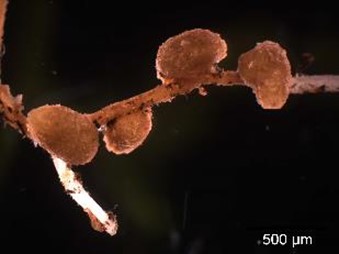
Dorycnium pentaphyllum and rhizobia nodules (© S. Soussou, Fertil’innove Environnement)
NS3: SENTEIN (Ariège, FR)
Snow does not allow access to the Sentein site until mid-May. In previous works, 103 locations, corresponding to the uses observed and most often specified directly with the residents concerned, were the subject of a health risk assessment in 2015. This concerns public leisure areas (the school, the leisure center and the municipal campsite of Sentein…), temporary and permanent residences, areas for walks and picnic, etc.
9 rearing areas were studied, showing, in some cases, very high Pb, Zn, and As concentrations in the soils, and sometimes in the watering waters. It was recommended to redevelop the 2 courtyards of the school and the leisure center to remove the contaminant exposure, to remove exposure to outdoor floors for 7 residences, to limit soil exposure and consumption of vegetables produced in 8 vegetable gardens, to consider the establishment of playgrounds outside polluted areas for 5 residences, to put in place devices to prevent access to mining deposits, to secure the 2 mine tailings deposits and the abandoned mines, to determine the best possible solution to limit the regular input of Pb- and Zn-laden sediments into the Lez river, to limit the exposure of livestock to certain highly polluted mining deposits and control the quality of the food produced, to avoid the soil reworking and maintain the grassland in good condition, to control the chemical quality of the soils before any external development requiring soil reworking, and to preserve the memory of the pollution sources.
Data on soil-plant transfer are currently not well documented. Data were collected on the plant species present at the Sentein site. Plant-plant interactions were studied at the Chichoué, Le Bocard, Le Talus and La Plagne tailings, differing in soil metal (Zn/Pb) contamination and altitude. Several plant species are identified as metallophytes and excluders.
It was possible to go to the site in mid-September 2021, despite the difficulty of access, and soil samples were collected from both the lower part of the site and the mining area, which were transferred to the partners. Botanical surveys were also conducted, and some invertebrates were obtained for WP3. Soil and shoot analysis and pot experiments for soil amendments are planned for spring 2022.
The topsoils of the toposequence from Le Bocard to Chichoué were analyzed showing a strong relationship between 1M NH4NO3-extractable soil Zn (a proxy of potential phytoavailable soil Zn) and soil pH (depending also to total soil Zn due to the former mining/smelting activities). The soil phytotoxicity evidenced in situ is explained by extractable soil Zn (related to soil pH and total soil Zn), and total and extractable soil Cu (in line with organic soil C). Visible symptoms of phytotoxicity were evidenced on shoots in a plant testing with dwarf beans. The incorporation of compost into these soils enhanced the plant growth and decreased the soil phytotoxicity. The combination of dolomite with compost was not additionally improving the shoot biomass.

Plant testing on potted sols from the Sentein site: untreated soils (Unt), compost-amended soils (OM), and soils amended with compost and dolomite (OMDL) (© Mench, INRAE)
NS4: BORDES (Pyrénées-Atlantiques, FR)
The open-air landfill at Bordes was operational for nearly fifty years. During that time, the Gave de Pau, initially located several meters from the site, changed its course to gradually erode the landfill at the rate of its floods. The banks of the Gave between Bordes and Pau, some twenty kilometers downstream, were regularly littered with debris of all kinds.
Faced with this environmental emergency, the town of Bordes and the community of communes of the Pays de Nay received ERDF funding to rehabilitate the site. The landfill-mining technique made it possible to return the sorted macro-waste to the recycling process. The fine soil fractions (0-20 mm) could be preserved on site, despite the excess of metal(loid)s over the crude fractions, subject to an environmental diagnosis that concluded that they were harmless and could host a plant cortege typical of the surrounding landscape.
A transfer of hay from local meadows combined with a hydromulching sowing of local seeds was carried out. In less than a year, these actions enabled the beginning of a grassland cover to establish.
In the winter of 2020, hundreds of trees representative of the local community (ash, willow, alder, hazelnut, etc.) were transplanted throughout the site to recreate a meadow planted with young trees, and then move towards an increasingly wooded canopy, designed to blend in with the surrounding riparian zone and phytostabilize the residual pool of contaminants.
Nowadays, data are collected on soil microbial communities and ecotoxicity bioassays are ongoing. The plant testing with dwarf beans did indicate no phytotoxicity of the soil.
There is a presence of contaminants in the soils of the site, but they no longer migrate (or very little) via the soil solution (soil pore water) to the ecosystem compartments and biological receptors in the surrounding area (except during floods).
Microbial communities in the landfill soil show marked changes in their ecological functions compared to adjacent forest soils. This finding has a twofold explanation: it partly reflects a direct deleterious impact of pollution on this biological compartment, but it can also be explained by the absence of mature plant cover.
Following the landfill rehabilitation, the cleaning of the macro-wastes associated with the programmed introduction of plant species will progressively reset a plant community trajectory that will return organic matter to the soil and gradually restart its enzymatic activities (ecological function).
The restoration of the vegetation cover on site should be carried out without any particular constraint related to the presence of soil contaminants, and the mesofauna should also be able to progressively reclaim the site without significant impediment from the residual contamination in place. However this must be evidenced by the biomonitoring.
Soil amendments, bioaugmentation, phytostabilization and phytoextraction of metal(loid)s, and rhizo/biodegradation of organic contaminants are under investigation. A pot experiment of topsoils collected at this site has evidenced no remaining visible phytotoxicity on the shoots (on a sensitive plant species such as dwarf beans) and seed banks with a relatively high biodiversity for such contaminated soil. The addition of compost stimulated the plant growth and the diversity of the plant community.

Potted Bordes soil without (left) and with (right) compost addition (© Mench, INRAE)
NS5: BANDEIRA (Galicia, ES)
The soil at the Bandeira site is derived from the ultramafic rock exploited in the quarry. The pseudo-total concentrations of potentially toxic trace elements (Ni, Cr, Co, and Zn) are similar to those in forest and agricultural soils of Galician ultramafic environments. Moreover, the available concentration of Ni and Co is low (< 75 mg kg-1) and that of Cr is under the quantification limit. The percentage of fine particles in the abandoned area is low and the precipitation and atmospheric humidity high (except few days in the summer season), which maintains the substrate wet. These characteristics restrict the potential transfer of dust to the vegetation and fauna in the area.
For all those reasons, the area cannot be considered a contaminated environment and we have not identified potential risks for the flora, fauna or humans. The proposed activities in the area aim improving the provision of ecosystem services of a non-contaminated but degraded area.
A preliminary field trial was established at the end of 2015 to evaluate the potential for nickel agromining in Ni-rich mine tailings. At this site, different nickel hyperaccumulators are being tested to select adequate plant species. Different soil amendments derived from biosolids and other stabilized organic wastes are being tested to improve plant growth and biomass production.
In February, seeds of two different Ni hyperaccumulating species, B. emarginata and B. tymphaea, were germinated in a mixture of garden substrate and serpentine soil collected in the ultramafic area of Serra do Careón (close to the Bandeira quarry). The seedlings were allowed to grow for 2 months in the greenhouse with regular watering.
In early spring, the experimental plots of the Phy2SUDOE project were established. The seedlings of B. emarginata and B. tymphaea were planted in plots treated with municipal solid waste compost, grape bagasse or apple bagasse. Municipal solid waste compost is assessed at three different rates: 100, 200 and 400 t ha-1 (equivalent to 2.5% 5% and 10% w/w), grape bagasse and apple bagasse were added both at 2.5% w/w. Each amendment and dose covered an area of 100 m2 and was divided in 16 plots of 4m2 separated by 0.5 m belts. In each amended area half of the plots were planted with B. emarginata and the other half B. tymphaea. The plants were distributed at a density of 4 plants/m2. In total about 400 seedlings of each species were transplanted to the quarry. An irrigation system is installed to guarantee watering during the drier season of the year (usually only necessary in July and August). Soil samples were collected for the initial evaluation of the substrate properties.
Experimental plots have been placed to test three amendments sites in the quarry area, with different plants and densities, and the biomass and survival rate of these plants is being monitored. This experimentation will continue next year, which is facilitated by the irrigation systems installed, and it is expected to have more data for this site in 2022 following the collection and analysis of plant leaves. The next steps are to prepare new pot plantings for early spring 2022, to collect more plant samples and monitor biomass.
Plots were stablished in the quarry area to test 3 amendments and Ni-phytomining: municipal solid waste compost (at three increasing rates: 2.5% 5% and 10% w/w), grape bagasse (2.5% w/w), and apple bagasse (2.5% w/w). In each amended area two Ni-hyperaccumulating plant species are being tested: Bornmuellera emarginata and Bornmuellera tymphaea. The plants were distributed at a density of 4 plants/m2. An irrigation system was installed to guarantee watering during the drier season of the year. Since January 2022, dead individuals were replaced in plots established in 2021. New plots were planted with B. emarginata and B. tymphaea. Attention was focused on areas with 2.5% and 5% of compost. About 300 new seedlings were established. Since May 2022, survival rate was evaluated and first shoot harvest realized. Good survival rate was evidenced in plots with 2.5% and 5% compost planted in spring 2021 and January 2022. Poor survival rate and plant growth occurred in plots amended with grape bagasse and apple bagasse established in 202. The survival rate was dramatically decreased in plots with 10% compost due to overgrowth of weeds. The B emarginata, planted in 2021, were harvested in plots with 2.5% and 5% compost (in advance flowering stage). Currently little or negligible growth of plants was noticed for those planted in January 2022. Analysis of shoot ionomes is ongoing. Noccaea caerulescens will be tested in the plots by direct sowing in the field.
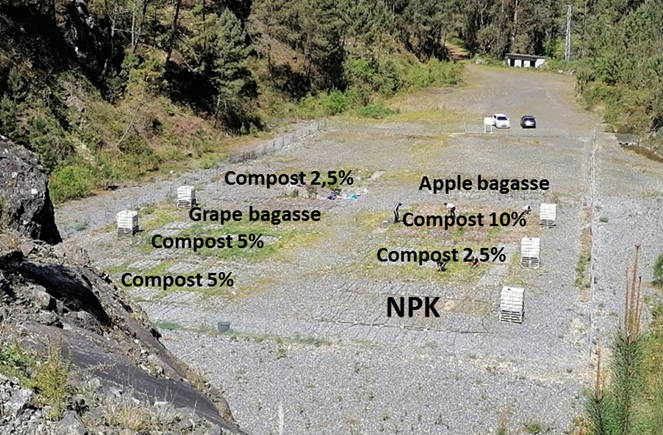
Field trial at the Bandeira site, Spain (© B. Rodriguez et al., CSIC)
NS6: GERNIKA (Basque Country, ES)
The site of Gernika, located in the Biosphere Reserve of Urdaibai, exhibits mixed contamination (Cd, Cr, Ni, Pb, dieldrin, benzo(a)pyrene, benzofluoranthene, and benzanthracene) due to uncontrolled applications of sewage sludges from an urban wastewater treatment plant for decades.
Field sampling was carried out in the Landfill 17 at two different periods, May 2015 and May 2018. Taking into account the diffuse character of the pollution, sampling points were homogeneously distributed in order to cover the largest area of the landfill. Soil samples were manually collected from the soil surface and transported under controlled temperature (4-7 °C), humidity and darkness conditions to the laboratory.
Nowadays, the following compounds are under quantification according to quality standards: Metal(loid)s, cyanides, volatile compounds, phenols, PAHs, organo-halogenated volatile compounds, chlorobenzenes, chlorophenols, PCBs, chlorinated pesticides, hydrocarbons and amino compounds. Ecotoxicity bioassays with Eisenia fetida earthworms, Cucumis sativus, Lactuca sativa and Allium cepa and cultivable heterotrophic bacteria are ongoing.
The sampling point with the highest concentrations of critical pollutants (worst case scenario) was selected in order to carry out ecotoxicological bioassays. The study was focused on the critical pollutants: Cd, Cr, Pb, Ni, benzo(a)pyrene and dieldrin, estimated on a previous Quantitative Environmental Risk Analysis ordered by the Basque Government.
Acute toxicity tests, both filter paper test and artificial soil test, and earthworm reproduction test, were carried out with Eisenia fetida earthworms. OECD artificial soil was used as control. Earthworms were all healthy, sexually mature with a weight range between 300-500 mg (f.w.). Specimens were maintained under stock conditions: constant humidity (60%) and temperature (19°C) until experimentation. After earthworm exposure chemical analysis to determine pollutant tissue accumulations were carried out.
Community-level physiological profiles of cultivable heterotrophic bacteria were determined with Biolog EcoPlatesTM-. Data were calculated from Gompertz regressions (three parameters) of the obtained curves; (i) average well colour development (AWCD) was determined by calculating the mean of every wells absorbance; (ii) number of utilized substrates (NUS), i.e. number of substrates with an absorbance value>0.25; and (iii) Shannon’s diversity index (H’ = -Σpi log2 pi) was calculated considering absorbance values at each well as equivalent to species abundance.
Gernika: Various bioremediation options are established: C: Non-treated; E: earthworms (Eisenia fetida); B: bacteria (microbial consortium); P: plants (alfalfa); P+B: plants + bacteria; P+E: plants + earthworms; B+E: bacteria + earthworms; and P+B+E: plants + bacteria + earthworms. The best elimination yields, and lowest variabilities in the reduction of contaminants, seem to be obtained in P+E, B+E and P+B+E treatments (dual and triple). The best elimination yields for the P+B+E treatment were: Dieldrin (between 50% and 78%), Metals (20–25%, Cd 15%–35%; Ni 24%–37%; Pb 15%–33%; Cr 7%–39%), Benzo(a)pyrene (19.5%–28%). Quantitative risk assessment is ongoing.
Ecotoxicological tests and bioassays: earthworms, plants and bacteria
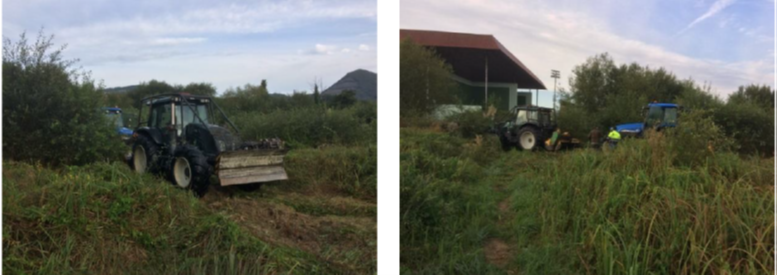
Preparation of the Gernika field trial (© M. Soto et al., UPV)
NS7: ZUMABAKOTXA (Vitoria-Gasteiz, Basque Country, ES)
The Industrial State of Jundiz (West of Vitoria-Gasteiz) significantly grew in the last decades and public lands adjacent to road infrastructures were used for landfills. Although those lands were originally planned as green areas due to the lack of use and its peripheral location earth movements were followed by uncontrolled dumping and illegal spills, thus creating a series contaminated plots that degrade the environmental quality and landscape. The anthropic landfills are very variable in typology and depth, consisting mostly of excavation lands and rocks, but in some cases also include construction and demolition waste and others.
Field sampling detected the presence of pollutants at different depths. The plots selected for this project include those areas where the pollutant concentration founded surpassed the limits set by the regional legislation (VIE-B levels). The compounds detected have been mainly polychlorinated biphenyls and petrol hydrocarbons.
The depth of the infill recorded until reaching the mother varies from 2 m. to 5 m. The bedrock is limestone marls. Over it many different spills, mostly arids from construction and demolition were deposited. Pollutants found in the surrounded area investigation included metals (Sb, As, Cu, Pb, Zn) and organics (HCH, PCB, PAH and solvents).
An area of low pollution was selected for establishing site S5; however, after preparing the land site for plantations, soil analyses of 18 samples were done and the results showed no pollution on the surface soil. Soil has basic pH and a lack of nutrients, but no surface pollution. Later, another subsite (S5b) was stablished in a higher level of pollution area.
The area has been colonized by ruderal vegetation once the landfill finished, mostly herbaceous. Some scarce trees and shurbs can be found around the site.
Being a place of little transit, it is considered practically null the possibility of contamination of people by ingestion or direct contact. In rainy seasons, when small rafts created, contaminants could be transferred from the water to wild animals (roe deer, foxes, small mammals, mustelids, amphibians, crustaceans, reptiles) by ingestion of herbaceous or runoff water. Considering that (i) levels of concentration are not high (ii) bioavailability of organics is low and (iii) aging by long term presence, the risk of dispersion out of the site is considered low.
Field plots with various phytomanagement options are carried out, i.e. regeneration meadow, Gall oak forest, Holm oak forest, and willow/poplar stand. CEA is maintaining the plots (replanting of died plants, weeding, etc.) and doing the soil and plant analysis. Soil qualitative analysis were done with Soil Cards in April 2022 (CEA and Neiker). Changes in soil pollution is under investigation, as well as plant analysis.
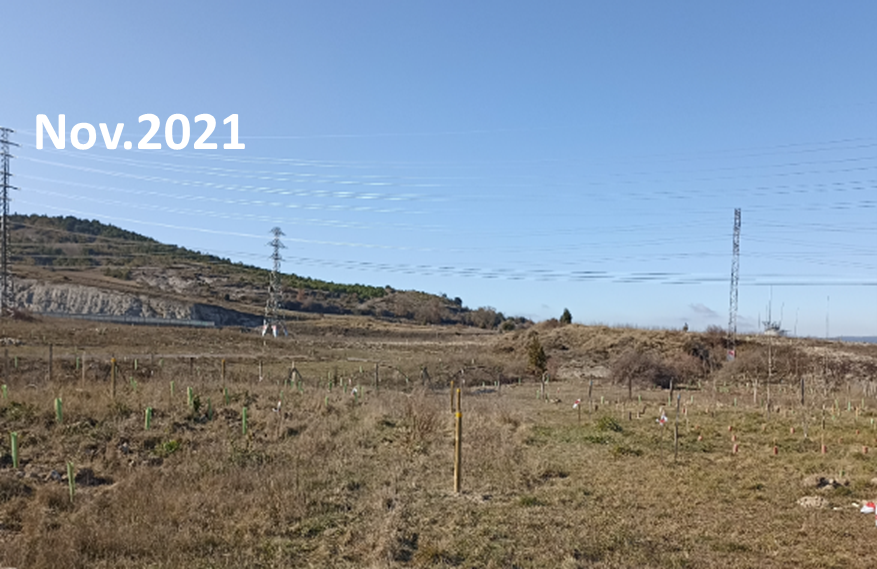
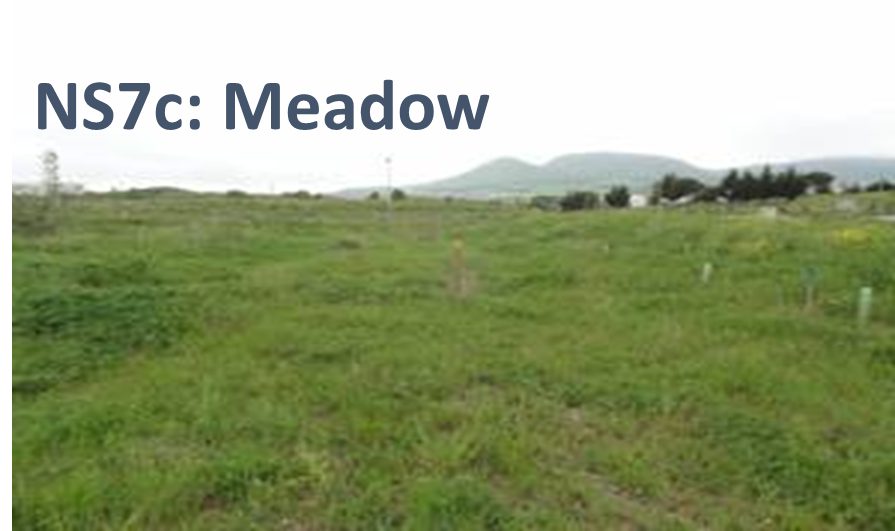
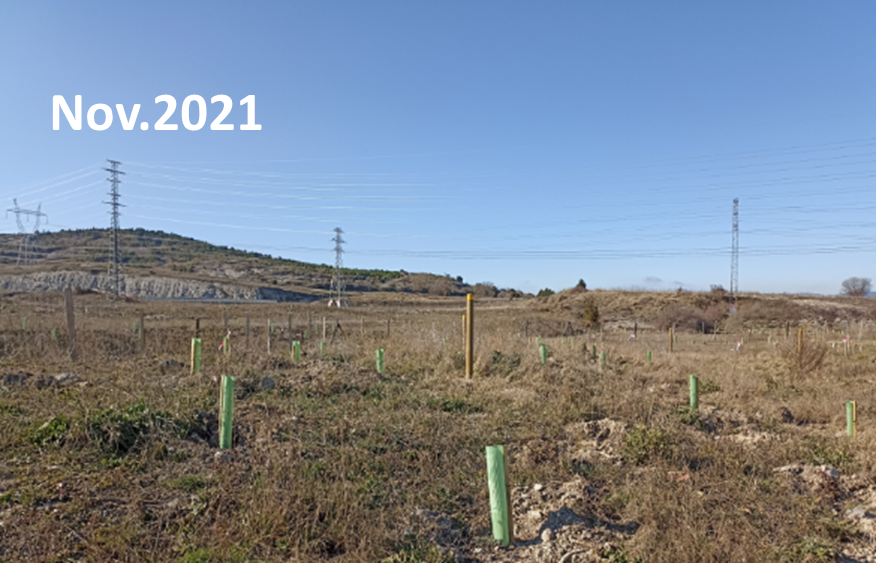
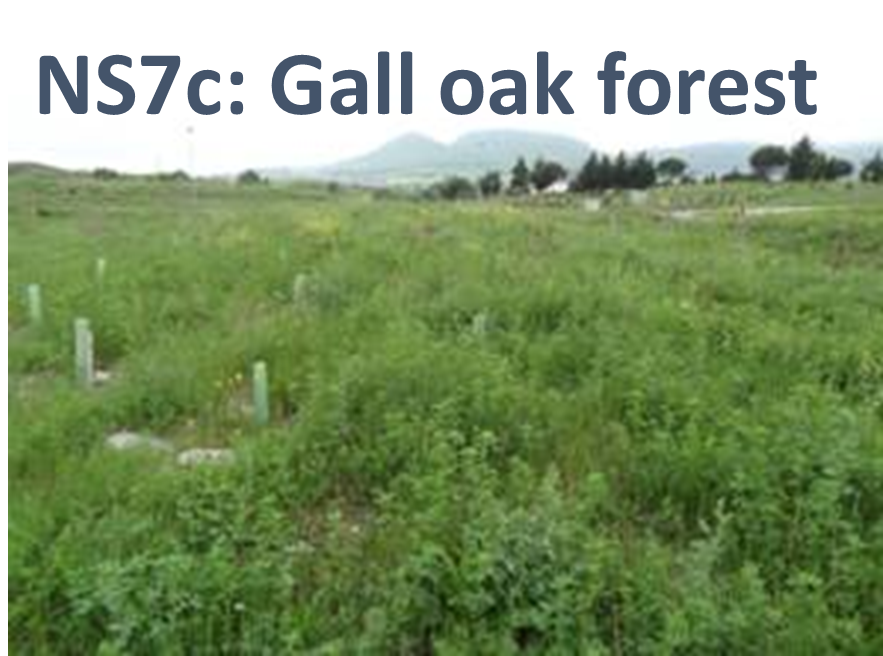
Field trials at Zumabakotza, Spain (© J Vilela et al., CEA)
NS8: ESTARREJA (Aveiro, PT)
The “Área do Segmento 1 da Vala de S. Filipe” site is located in the vicinity of a large chemical industrial complex, located in Estarreja, Portugal. It is an area with high permeability and with an average depth to the groundwater level of less than 1 meter, with seasonal flooding due to the rise of the aquifer. Such characteristics have led to the construction of a network of draining ditches, enabling the agricultural use of the land.
Over 5 decades, starting circa 1940, the chemical complex has used some of ditches for conveying the discharge of wastewater, with high contents of aniline and derivatives, and other organics, ammonia and metal(loid)s mainly As, Hg, Pb and Zn. The concentration of both major contaminants before the remediation average 3298 mg As/kg (around 3000 mg/kg at 25 cm depth,) and 89 mg Hg/kg (around 50 mg/kg at 25 cm depth). Organic contaminants have not been quantified, but due to the site history, there is knowledge of contamination due to hydrocarbons: benzene, toluene, ethyl benzene, xylene, PAHs.
The site will undergo a large remediation project in 2021. However, on the southern limits of the major intervention zone plot will be established for the needs of Phy2SUDOE. The area, to be precisely defined in January 2021 in order to comply with the requirements of the remediation project, will be located around a central point with the approximate coordinates (N40º46’1’’; W08º34’49’’). Activities related to WP1, 2 and 3 will be run on this site.
The objective is to phytostabilize the metal(loid)s and to promote the degradation of the organic contaminants (PAHs, BTEX). Sampling of soil and soil macro-fauna using Pitfall traps were carried out. 14 sampling points were assessed in the study area and 1 in the reference area. 16 bait lamina were deployed at each soil sampling point and 20 in the reference sampling point. The bait-lamina test is an in situ method intended to evaluate the feeding activity of soil organisms. Several tasks are ongoing: phytoremediation planning according to the analytical characterization of the site, phytoremediation deployment, retrieval and analysis of bait lamina, and processing of the collected samples of macro fauna. Cutting of poplars and willow (from INRAE) were implemented with mycorrhizae and either intercropped with vetiver (poplars) or cultivated on soil amended with hydrogel (willows).
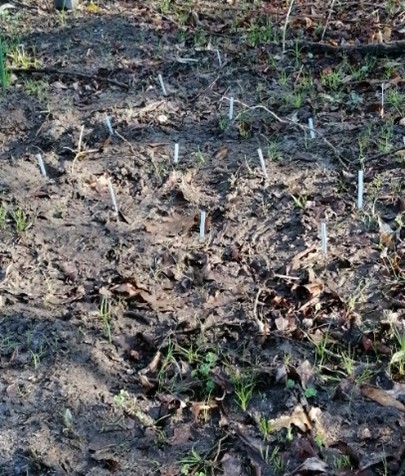
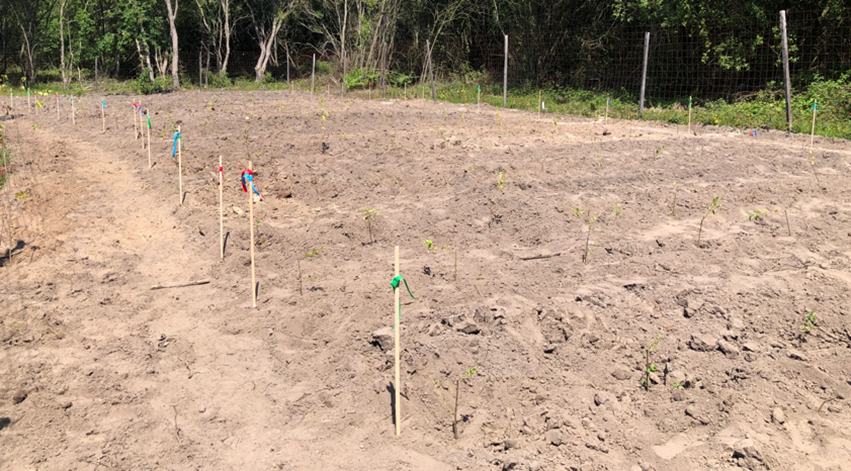
Deployment of bait-lamina and field trial at the Esterreja site (© UCP)
The results will reflect the conformation and status of the new extended network of PhytoSUDOE Network phyto-managed sites (PhytoSUDOE sites + Phy2SUDOE sites).The global objective of GT2 is to identify the links between structural (taxonomic, phylogenetic) and functional biodiversity in phytomanaged soils, compared to non-phytomanaged contaminated and non-contaminated soils. Due to the importance of soil biota for soil functionality and ecosystem services, one of the key questions will be whether soil functioning depends on species richness, key species, species traits or community composition.
